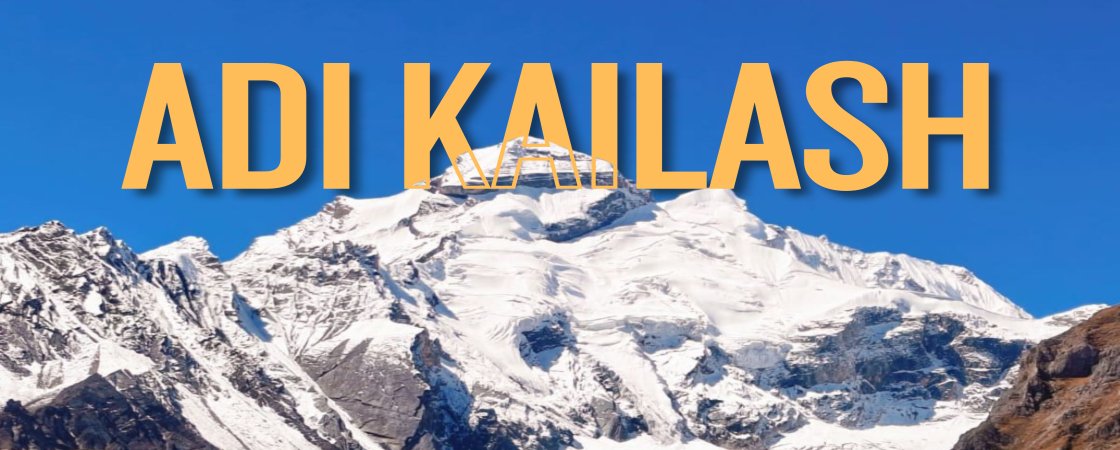Adi Kailash, also known as Chhota Kailash, is located in the Kumaon Himalayas of Uttarakhand, near the India-China border. Revered as one of the Panch Kailash pilgrimages, it attracts devotees of Lord Shiva and adventure seekers alike. Reaching Adi Kailash requires navigating remote mountain terrain, and planning is essential.
Where is Adi Kailash located?
Adi Kailash is situated in Kutti Valley, Pithoragarh district, Uttarakhand. It lies close to the Indo-Tibet border, near Om Parvat and Gunji village. The region is remote, and access is limited to specific months due to weather and security conditions.
How to Reach Adi Kailash from Delhi, Kathgodam, or Pithoragarh?
1. By Air (Nearest Airport: Pithoragarh – Naini Saini Airport)
Delhi to Pithoragarh (via Pantnagar or direct small flights).
From Pithoragarh, travel by road to Dharchula, the base town for the Adi Kailash Yatra.
Helicopter services are sometimes available from Pithoragarh to Gunji (only for official tours or during Yatra season, depending on permits and weather).
Delhi to Pithoragarh (via Pantnagar or direct small flights).
From Pithoragarh, travel by road to Dharchula, the base town for the Adi Kailash Yatra.
Helicopter services are sometimes available from Pithoragarh to Gunji (only for official tours or during Yatra season, depending on permits and weather).
2. By Rail (Nearest Station: Kathgodam)
Take a train from Delhi to Kathgodam (approx. 6-7 hrs).
From Kathgodam, hire a cab or board a bus to Pithoragarh (approx. 240 km / 8-10 hrs).
Then continue by road to Dharchula and onwards to Gunji.
Take a train from Delhi to Kathgodam (approx. 6-7 hrs).
From Kathgodam, hire a cab or board a bus to Pithoragarh (approx. 240 km / 8-10 hrs).
Then continue by road to Dharchula and onwards to Gunji.
3. By Road (Delhi–Adi Kailash Road Route)
Route: Delhi ? Haldwani ? Pithoragarh ? Dharchula ? Gunji ? Adi Kailash
Total travel time: 3–4 days, including overnight halts
The road journey involves steep mountain roads, especially after Dharchula.
Route: Delhi ? Haldwani ? Pithoragarh ? Dharchula ? Gunji ? Adi Kailash
Total travel time: 3–4 days, including overnight halts
The road journey involves steep mountain roads, especially after Dharchula.
What is the Best Route for Adi Kailash Yatra?
The yatra starts from Dharchula, where all pilgrims must obtain an Inner Line Permit (ILP). The typical route includes:
Dharchula to Gunji (via Tawaghat, Budhi, and Garbyang)
Gunji to Kuti Village
Kuti to Jyolingkong – Base of Adi Kailash Parvat
From Jyolingkong, trekkers get a panoramic view of Adi Kailash and perform parikrama.
Can You Drive to Adi Kailash?
No, you cannot reach the peak directly by vehicle. However, the road has been developed till Jyolingkong, which is the last motorable point. From here, a short trek takes you to the Adi Kailash viewing point. Only permitted government vehicles or official groups can travel on this stretch beyond Gunji.
Important Travel Tips for Adi Kailash
Permit Required: ILP is mandatory for all pilgrims.
Travel Season: May to mid-October (July–August sees heavy rain).
Weather: Cold, even in summer. Temperatures drop near freezing at night.
Altitude: Jyolingkong is at ~4,800 meters—AMS (altitude mountain sickness) can occur.
Trek Difficulty: Moderate, but involves long distances at high altitude.
Permit Required: ILP is mandatory for all pilgrims.
Travel Season: May to mid-October (July–August sees heavy rain).
Weather: Cold, even in summer. Temperatures drop near freezing at night.
Altitude: Jyolingkong is at ~4,800 meters—AMS (altitude mountain sickness) can occur.
Trek Difficulty: Moderate, but involves long distances at high altitude.
Summary
Reaching Adi Kailash is an adventurous and spiritual journey. Whether you're traveling from Delhi, Kathgodam, or Pithoragarh, your path leads through the Himalayas to one of the holiest abodes of Lord Shiva. Careful planning, permits, and preparation are essential to ensure a smooth yatra.



